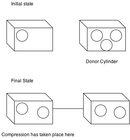At least this is a new way to express the same argument - graphically. It's creative thinking like this that makes it worthwhile.
You are making the residual air argument by leaving air in the second tank. I agree the residual air in that second tank is being compressed. The escaping air is expanding. If the single unit of air in the second tank is at 1 bar, then we need to put 200+ units in the first tank for 3000 psi. The expansion of 200+ units into twice the volume overcomes the effect of the compression of one. Only the one single unit of air sees compression. All the others see expansion.
It still doesn't explain why my oxygen tank heats up when they evacuate it (for safety) before filling.
I don't know if you've followed all the thread (heaven forbid!) but there are at least two other good arguments beyond the "residual air" argument. One is the leakage of heat energy into the system at the fill valve and one is the non-ideal nature of air. All three are good arguments, and some convinced me for several years, but I kept coming back to the fact that we can eliminate all of them. Evacuate the tank being filled - expanding air still gets hot. Insulate the valve - the air still gets hot. Use the ideal gas equations - the gas still gets hot.
---------- Post added February 27th, 2013 at 11:50 AM ----------
Perhaps this might help?
"There are plenty of cases though where gas might be taken from one container to another through a valve. And I've seen people talk about this in the same terms as the "free expansion" I just explained above, take this one for example:
Free Expansion
Although it is true that the total internal energy is the same in this once the pressures equalize, it is not true that the internal energy for each side is the same. They would have to mix completely and come to equilibrium after the pressures equilized in order for that to occur, so this very misleading. One wouldn't expect mixing to occur very effectively between these two volumes because of the restriction between them. What we find in this case is the gas on the high pressure side (side A) has actually expanded isentropically and all the entropy change is occurring on side B. If you apply the first law to each side independently, you'll find that to be the case."
Wow! An answer I agree with! I haven't looked at the free expansion link yet, but I'll assume until I do that it matches the Wikipedia free expansion link. The gas on one side does work and expands at nearly constant entropy. That cools it. It sends the energy extracted from that expansion into the gas going to the second tank. You can think of the gas on the other side as expanding with "free expansion = Joule expansion" which is a constant temperature expansion, coupled with heating from the energy transferred through kinetic energy converted to heat. Or you can just think of all the gas as undergoing free expansion at constant temperature, but it hasn't yet mixed thoroughly, so the colder gas is balanced by the heat in the hotter tank.
This is the key to the explanation. You can expand gas at constant entropy and make it colder by extracting energy (making the gas do work) or you can expand it at constant temperature by letting the entropy increase.
I was getting to the point where I thought no one would see the basic physics of the process. Perhaps you don't agree with everything I said, but at least you didn't say anything I disagreed with and at least in my own mind, it's a perfect match for what I've been saying since I started to get a handle on what was happening.
Edit - I looked at that link. Yes, it states exactly what the Wikipedia article says.






